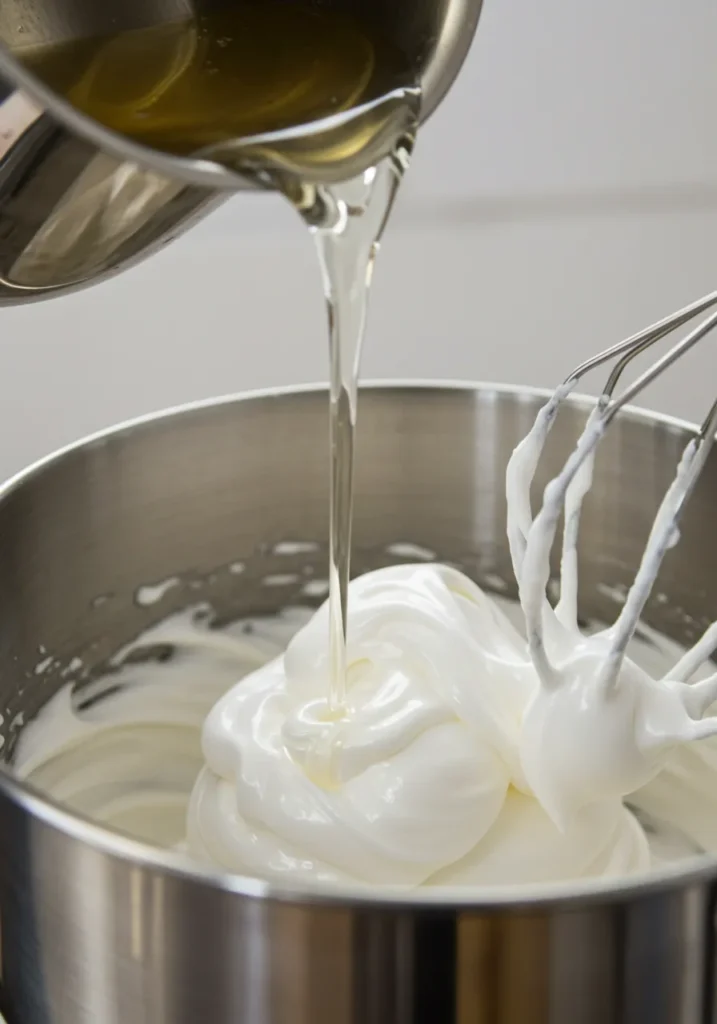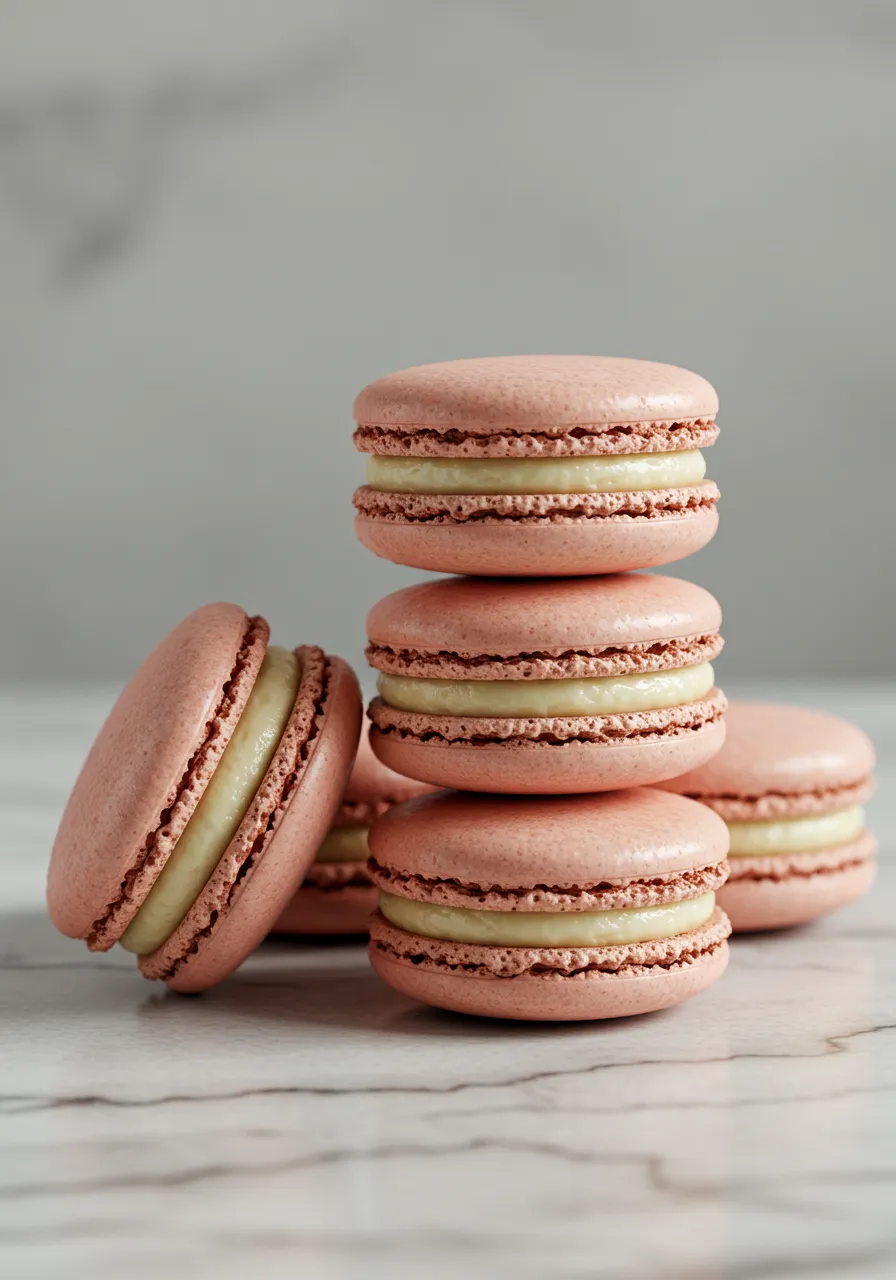Tired of finicky French macarons that crack at the mere thought of humidity? Mastering the perfect italian macaron recipe can feel like a far-off dream, but I’m here to promise you a reliable, repeatable path to success. After testing over 15 batches and analyzing the most common failure points, we’ve developed this data-driven italian macaron recipe to guide you to confectionary perfection. This isn’t just a recipe; it’s a macaron masterclass designed to make you succeed.
We’ve documented everything—the successes and, just as importantly, the failures—to show you precisely what to look for at every stage. This comprehensive guide for the italian macaron recipe will transform you from a hopeful baker into a confident macaron master.
Why This Italian Macaron Recipe Works: The Science

The secret to this recipe’s reliability lies in the Italian meringue. Unlike the French method, which uses raw egg whites, the technique for this italian macaron recipe involves pouring a hot sugar syrup into whipping egg whites. This cooks the meringue, creating a far more stable and predictable structure. It’s less susceptible to humidity and under-mixing, two of the biggest culprits behind macaron mishaps.
Here’s a quick breakdown of the key players:
- Almond Flour: Provides the essential structure and nutty flavor.
- Aged Egg Whites: This simply means egg whites separated a day in advance and left in the fridge. This lowers their water content, allowing them to whip up into a stronger meringue.
- Sugar Syrup: The cooked sugar is the star of the Italian method, creating that famously stable meringue.
Essential Equipment for This Italian Macaron Recipe
Precision is everything. To succeed with this italian macaron recipe, having the right tools is non-negotiable. While you can sometimes get away with estimations in other baking, macarons demand accuracy.
- Digital Kitchen Scale: This is the most crucial tool. Volume measurements (cups) are wildly inconsistent. For macaron success, you must weigh your ingredients in grams.
- Stand Mixer: While a hand mixer is possible, a stand mixer provides the power and stability needed to whip the meringue while you pour the hot sugar syrup. It’s a game-changer for consistency.
- Candy Thermometer: Guessing the temperature of your sugar syrup is a recipe for disaster. A reliable digital or candy thermometer ensures you hit the precise “soft-ball” stage required.
- Piping Bags & Round Tips: For uniform, round shells.
- Silicone Baking Mats or Parchment Paper: To prevent sticking and promote even baking.
- Sifter or Food Processor: To ensure your dry ingredients are exceptionally fine, which is key to a smooth shell.
Ingredient Deep Dive: Precision is Key

The ingredients for this italian macaron recipe must be precise. Always measure in grams for accuracy.
- Almond Flour: 150g
- Powdered Sugar: 150g
- Egg Whites: 110g (divided into two 55g portions), aged for 24 hours
- Granulated Sugar: 150g
- Water: 50g
- Gel Food Coloring: A few drops (optional, avoid liquid coloring)
Expert Tip: Almond Flour vs. Almond Meal Use “super-fine” almond flour, not almond meal. Almond meal is coarser and contains the skins, which will result in a bumpy, textured macaron shell. We tested both, and the visual difference is stark. The finer the flour, the smoother the finish.
Expert Tip: The Importance of Aged Egg Whites Aging egg whites by separating them and letting them sit in the fridge for 24 hours reduces their moisture content. This allows them to whip into a more voluminous and stable meringue. Don’t skip this step!
Expert Tip: Can I Reduce the Sugar? In short, no. The sugar is not just for sweetness; it’s a critical structural component. Reducing it will cause your italian macaron recipe to fail.
The Step-by-Step Italian Macaron Method (With Photos)

Follow these steps meticulously for our italian macaron recipe. Each stage builds upon the last, so pay close attention to the visual cues.
Step 1: Preparing the Almond Paste (Tant Pour Tant)
“Tant pour tant” simply means “equal parts.” Sift the 150g of almond flour and 150g of powdered sugar together into a large bowl. This removes lumps and aerates the mixture. Add one 55g portion of aged egg whites. Mix until it forms a thick, uniform paste. This is your almond paste base.
Step 2: Cooking the Sugar Syrup
In a small saucepan, combine the 150g of granulated sugar and 50g of water. Stir just until the sugar is dissolved. Clip on your candy thermometer. Bring the mixture to a boil over medium-high heat. Do not stir it once it begins to boil. You are aiming for 244°F (118°C). This step is what makes the italian macaron recipe so stable.
Step 3: Making the Italian Meringue
While the syrup heats up, place the remaining 55g of aged egg whites in the clean bowl of your stand mixer fitted with the whisk attachment. When the sugar syrup reaches about 230°F (110°C), start whipping the egg whites on medium-high speed until they form soft peaks.
Once the syrup reaches 244°F (118°C), immediately remove it from the heat. Turn the mixer down to medium-low and slowly pour the hot syrup in a thin, steady stream down the side of the bowl. Avoid pouring it directly onto the whisk. Once all the syrup is incorporated, turn the mixer up to medium-high and whip until the meringue is glossy, stiff, and the outside of the bowl is warm (not hot) to the touch. The meringue should form a “bird’s beak” peak that is stiff but has a slight curve at the tip.
Step 4: The Macaronage (Combining & Folding)
This is the most critical step of the italian macaron recipe where you combine the meringue with the almond paste. Add about one-third of the meringue to the almond paste and mix it in vigorously to lighten the paste. Then, gently fold in the remaining meringue in two additions. The goal is to deflate some of the air. You’re looking for the batter to flow off the spatula in a slow, continuous ribbon that takes about 8-10 seconds to melt back into the batter. This is the “lava” consistency.
Step 5: Piping and Resting
Transfer the batter to a piping bag with a round tip. Pipe 1.5-inch circles onto your prepared baking sheets. Firmly rap the baking sheets on the counter a few times to release any air bubbles. Let the piped macarons rest at room temperature for 30-60 minutes, or until they form a dry skin that you can touch without any batter sticking to your finger. This step is crucial for developing the “feet.”
Step 6: Baking to Perfection
Preheat your oven to 300°F (150°C). Bake the macarons for 14-16 minutes, one sheet at a time. They are done when the tops are firm and don’t wobble when you touch them. Let them cool completely on the baking sheet before attempting to remove them.
The Macaron Troubleshooting Matrix
Even the best baker can run into trouble, so we created this troubleshooting matrix specifically for our italian macaron recipe. Instead of guessing, find your issue here and fix it.
| Problem | Likely Cause(s) | How to Fix It |
| Cracked Shells | Over-mixed batter; oven too hot; didn’t rest long enough. | Fold less during macaronage; use an oven thermometer; ensure a dry skin forms before baking. |
| No “Feet” | Under-mixed batter; rested for too little/too long; oven temp too low. | Ensure proper “lava” consistency; test for a dry skin; check oven temperature. |
| Hollows | Over-whipped meringue; under-baked; oven temp too high. | Whip meringue to a “bird’s beak,” not bone-stiff; bake longer; lower oven temperature slightly. |
| Lopsided Shells | Uneven piping; oven has hot spots; baking sheet is warped. | Pipe straight down; rotate pan halfway through baking; use flat, heavy-duty baking sheets. |
| Sticky/Gummy | Under-baked; high humidity. | Bake for an additional 1-2 minutes; use a dehumidifier or wait for a dry day. |
| Browned Tops | Oven too hot; rack too close to the top. | Lower oven temperature; move the rack to the middle of the oven. |
Frequently Asked Questions (FAQ)
Can I make macarons on a humid day?
With the Italian method, it is more forgiving. However, for best results with any italian macaron recipe, avoid very humid days. If you must, you may need to increase the resting time for the shells to form a skin.
How do I store macarons?
Store unfilled shells in an airtight container at room temperature for up to 2 days or in the freezer for a month. Once filled, store them in an airtight container in the refrigerator for 2-4 days.
My macarons are hollow. What did I do wrong?
This is one of the most common issues. It’s usually caused by an over-whipped meringue or under-baking. Ensure your meringue has a glossy, firm peak (not dry and chunky) and that the shells are fully baked before removing them from the oven.
Can I use a hand mixer?
It is very difficult but not impossible. You need excellent coordination to pour the hot syrup while simultaneously mixing. A stand mixer is highly recommended for safety and consistency with this italian macaron recipe.
What fillings work best?
Buttercream, chocolate ganache, and fruit curds are excellent choices. Avoid watery jams, as they will make the shells soggy. The filling should be thick.
Did You Try Our Recipe?
There are no reviews yet. Be the first one to write one.

